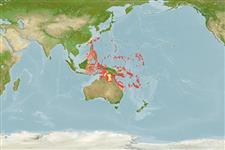Common names from other countries
>
Acanthuriformes (Surgeonfishes) >
Acanthuridae (Surgeonfishes, tangs, unicornfishes) > Acanthurinae
Etymology: Ctenochaetus: Greek, kteis, ktenos = comb + Greek, chaite = hair (Ref. 45335); cyanocheilus: Named for its blue lips (Greek 'cyano' for blue and 'cheilos' for lip)..
More on authors: Randall & Clements.
Environment: milieu / climate zone / depth range / distribution range
Ecologia
marinhas associadas(os) a recifes; intervalo de profundidade 1 - 60 m (Ref. 90102), usually 7 - 15 m (Ref. 48637). Tropical; 28°N - 24°S, 115°E - 67°E (Ref. 37792)
Western Pacific: Ogasawara Islands, south through the Philippines and Indonesia to the Great Barrier Reef and New Caledonia, east to Samoa in the South Pacific, to the Marshall Islands.
Tamanho / Peso / Idade
Maturity: Lm ? range ? - ? cm
Max length : 16.0 cm SL macho/indeterminado; (Ref. 48637)
Espinhos dorsais (total) : 8; Raios dorsais (total) : 25 - 28; Espinhos anais: 3; Raios anais : 22 - 26. Color orangish brown to dark brown with bluish lines following scale rows; chest with bluish cast; head, anterior body above pectoral-fin base, and chest with very small pale yellowish spots; lips blue; orbit narrowly rimmed with dull yellow. Median fins dark brown, dorsal with bluish lines extending in from body. Young bright yellow. Lip margins smooth to finely papillate. Caudal fin emarginate (Ref. 42056).
Inhabits inner to outer reef with rich coral growth, usually on upper part of slopes in 7-15 meters depth (Ref. 48637). Solitary or in groups, grazing on algae (Ref. 90102). Maximum depth reported taken from Ref. 128797.
Ciclo de vida ou comportamento de acasalamento
Maturities | Reprodução | Spawnings | Egg(s) | Fecundities | Larvas
Randall, J.E and K.D. Clements, 2001. Second revision of the surgeonfish genus Ctenochaetus (Perciformes: Acanthuridae), with descriptions of two new species. Indo-Pac. Fish. (32):33 p. (Ref. 42056)
Status na Lista Vermelha da UICN (Ref. 130435)
CITES (Ref. 128078)
Not Evaluated
Ameaça para os humanos
Harmless
Uso pelos humanos
Ferramentas
Relatórios especiais
Baixar XML
Fontes da internet
Estimates based on models
Preferred temperature (Ref.
115969): 25.2 - 29.3, mean 28.6 (based on 1221 cells).
Índice de diversidade filogenética (Ref.
82804): PD
50 = 0.5020 [Uniqueness, from 0.5 = low to 2.0 = high].
Bayesian length-weight: a=0.02344 (0.01098 - 0.05004), b=2.97 (2.80 - 3.14), in cm Total Length, based on LWR estimates for this (Sub)family-body shape (Ref.
93245).
Resiliência (Ref.
120179): Elevada, tempo mínimo de duplicação da população menor que 15 meses (Preliminary K or Fecundity.).
Fishing Vulnerability (Ref.
59153): Low vulnerability (10 of 100).
